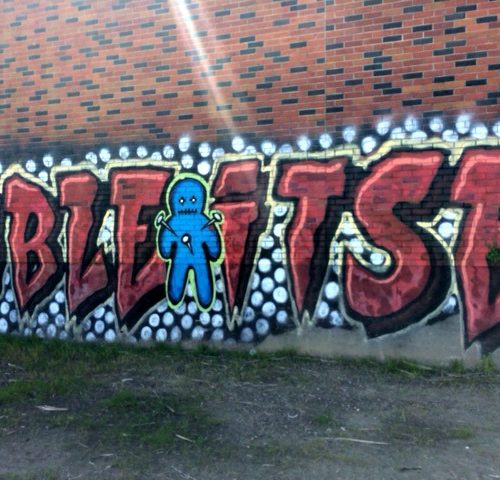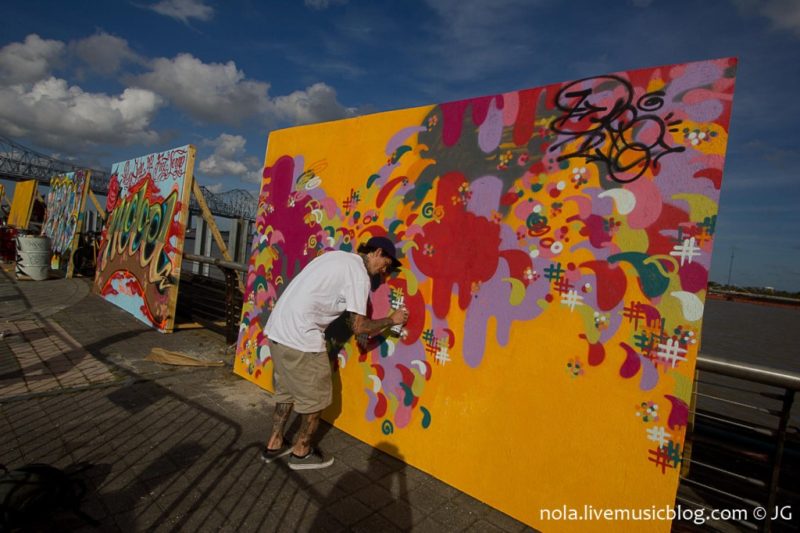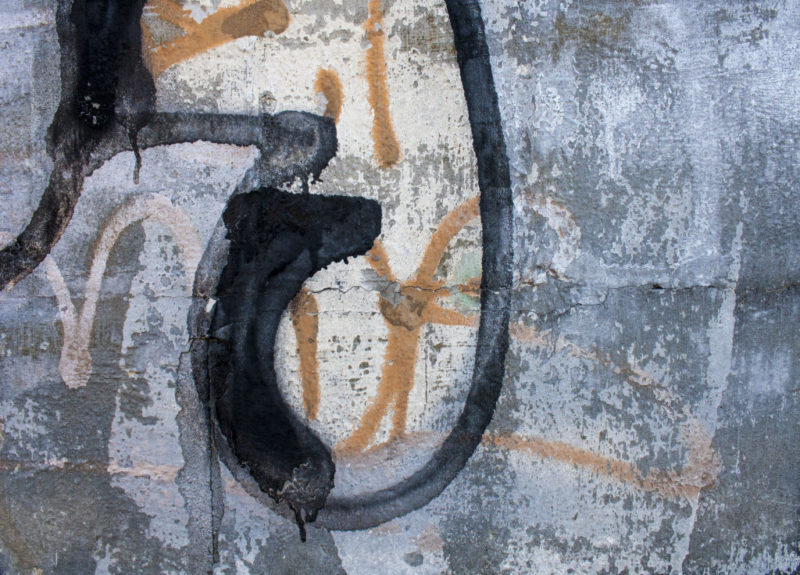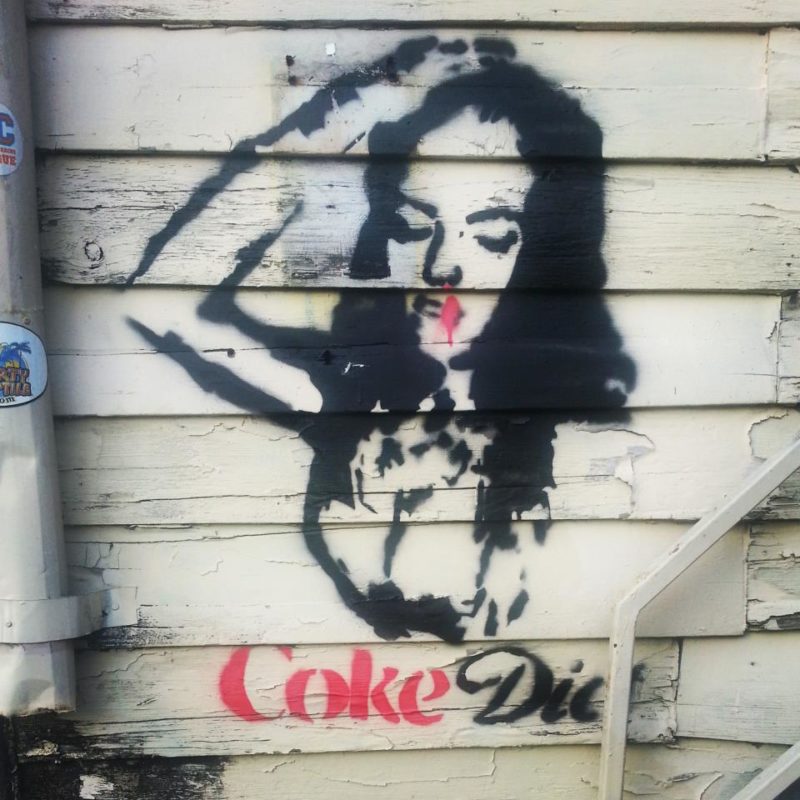
New Orleans graffiti (photo by: Kelley Crawford)
Street Art of Senegal and New Orleans
Graffiti writing and street art splash across walls and buildings of New Orleans and Senegal with the purpose of eliciting an emotional response from passers by. The powerful, aspirational images reveal a deep identification and empathy with the cultures of their communities. Graffiti and street art can be viewed as a form of cultural heritage (Siler).
SHARED HISTORY
A deep connection has formed among artists in New Orleans and Senegal due to the exchange of people, goods and culture from Senegambia across the Atlantic Ocean during the colonial era. “The thread that binds the quilt of Louisiana culture is African” (Siler). In 1719, the French transported two hundred slaves from Senegambia to New Orleans because the Senegal Valley resembled the Mississippi Valley (Siler). African cultural traits have persisted throughout Louisiana’s history, which is evident in its culinary, music, religion, dance and art.
The subcultural movement of hip-hop found its way from the inner cities of the U.S. to cities in Africa in the 1970s. The pioneers of graffiti artists, or graffeurs, in Senegal discovered graffiti through the hip-hop movement that came to them from the U.S. when magazine covers featuring hip-hop artists such as 50 Cent or Snoop Doggy Dogg show-cased the artists with graffiti (Rabine 93). Senegal now has one of the strongest international reputations for hip-hop among African countries (Rabine 98). Graffiti is the visual form of hip-hop so they are enmeshed.
Artists associated with this subversive, urban art movement have formed a global network of stylistic forms and knowledge. Most graffiti artists use variations of wild-style, 3-D and bubble style to express their themes. Wild style with its hyper-deformed, intertwined letters is the most difficult to write and to read. The word becomes a unit of expression (Rabine 103). Tagging is when the graffiti artist writes his name on a wall, usually with spray paint (Weisberg).
Street artists, who comprise a subset of graffiti artists, introduced other materials in addition to paint such as stickers, rubber stamps, stencils, charcoal and wheat-paste posters (Weisberg). Replication became faster and easier and artists branched away from typography into symbols and characters (Bates). “The two genres are inexplicably connected, both in origin and a broad sense of intent which is making the city your own by claiming the space” (Bates).
BEAUTIFICATION OR VANDALISM?
In the 1960s, France began to recruit thousands of Senegalese workers for manual labor. Senegalese men, who seek a better economic future, continue fleeing to Europe while many others have left their villages for Dakar (Guilbert). Following this urbanization, a popular sentiment was, “This street doesn’t belong to anybody.” However, graffeurs responded by saying, “But the walls belong to all of us. They’re for everybody” (Rabine 94).
When graffeurs paint, the walls must be clean; thus, social responsibility and “civic-minded communalism” becomes an important aspect of a graffeur’s life. Graffeurs say they “make the walls talk, we make the walls live” (Rabine 95). The Dakar artists connect with those who live in their city and they form their social identity through this prism. The neighborhood is their home, which they love and respect and find peace in (Rabine 95).
Enduring Senegalese values, including creativity, inspiration and technical ingenuity, enable graffiti artists to flourish in Dakar despite a dire lack of resources (Rabine 90). Unlike cities in Western nations, graffiti has never been an illegal activity in Dakar. As such, graffiti is supported by officials, residents and businessmen who view this art form as a way to cleanse and beautify disintegrating spaces in the economically impoverished city (Rabine 91).
This belief stands in sharp contrast to Western graffeurs. New Orleans experienced tremendous blight on its landscape in 2005 after Hurricane Katrina. The artist, Rex Dingler, established NoLA Rising by posting approximately 3,000 hand-drawn and painted signs to buildings, fences, and telephone poles. His artwork made him feel better and reflected the “city rising from the muck” (Ehrenfeucht 969).
In response, Fred Radtke, who was the founder and operator of a graffiti-removal organization called Operation Clean Sweep, painted over Dingler’s graffiti with gray primer paint, and thus became known as the “Gray Ghost” (Ehrenfeucht 969).
A New Orleans ordinance requires property owners to remove graffiti from buildings (Ehrenfeucht 969). The “broken windows theory” contends that graffiti creates adverse effects in neighborhoods, including decreased property values, other crimes being committed, the withdrawal of businesses, as well as fear and anxiety among residents (Ehrenfeucht 970).

Graffiti Artists at BUKU Music and Arts Project (Photo by: Jimmy Grotting)
Graffiti writers claim urban space as they move through the city using walls to publicly communicate. A problem with street art arises when the artist does not ask for permission to use private or public property for its public comments (Ehrenfeucht 967). Since graffiti has a bad reputation in the U.S., many artists prefer to be called “street artists” (Weisberg).
However, a new perspective of graffiti in New Orleans contends that “making street art is an individual act that engages with strangers along the streets” (Ehrenfeucht 966). Like other public spaces, streets are typical social areas where people engage and interact with one another, even if they are strangers, and diverse groups learn about each other.
STREET ART PROJECTS IN SENEGAL
The internationally known graffiti artist and leader of Dakar’s graffiti movement, Docta (Amadou Lamine Ngom, b. 1975), has said, “We are really socially conscious, super engaged by what goes on around us. Furthermore, our hip hop remains pure. It’s a hip-hop for the community; it defends the community and must speak to the community. If it doesn’t do this, it no longer has a raison d’etr” (Rabine 90). Docta considers graffiti to be a “divine expression translated into the human…it attracts the other because it’s divine. If it’s just human, it remains individual” (Rabine 97).
Since 2010 Docta has led a ten-day event, Festigraff, every year through his organization known as Doxadem Squad. During this event, 15-20 artists who are led by Mad Zoo collectively engage in mural painting on three successive walls. Apprentices first weed the area, remove stagnant pools of water, and pick up trash. Concrete walls are covered with white gesso in preparation for the experienced artists’ murals.
Mad Zoo, announces a one-sentence theme they will paint, which is a message to inspire the population to positive action. The message also “emphasizes the collective engagement of the artists.” For example, one message is “Believe in yourself for as long as it takes, and you will succeed.” Painting the wall is intense and the process seems magical as it combines a strong will to collectively influence the population (Rabine 91).

New Orleans graffiti (Photo by: Hanna Rasanen
On successive days, the artists move to locations further and further from the city. Their images include other inspirational words, such as “Dirtiness is bad; be clean inside, clean outside” (Rabine 92). Mad Zoo’s inspiration comes from a sense of duty, as well as pursuing a mission, which includes embarking on a solution to an ethical crisis. “What interests us is that we can talk to the population, that we can touch with our finger what the population is living through every day” (Rabine 97). (www.graffitisouthafrica.com/graffiti-africa-gallery/2015/04/10/an-overview-of-festigraff-hip-hop-festival-in-senegal/)
Some Senegalese artists have represented religious personalities and Muslim leaders on walls (Rabine 94). Pape Diop, transforms walls in Medina (Dakar’s old quarter) and Gueule Tapee (the boulevard that runs to and from the inner city of Dakar). His subtle designs are numerous and intense and depict the image of the Senegalese holy man, Sheikh Amadou Bamba, over and over (Roberts 53).
Amadou Bamba is a Sufi saint and Diop has chosen to repeatedly reproduce his image from a single, high-contrast photograph using black pigment on walls. The photograph does not reveal individual characteristics and makes Bamba appear as both divine and human (Roberts 56). The walls become an “active energy that heals, protects and helps in countless ways” for those who dwell near them or pass by them (Roberts 56).
Another artist, YZ (pronounced eyes), pays tribute to the women who fought against invaders and persecutors in the 19th century (Street Art). Inspired by the culture and history of Senegal, her Amazone series highlights Senegalese women who fought against French colonialists (Street Art).
She uses Indian ink on silk paper, which is then pasted on walls. The texture of the walls becomes apparent through the silk, which is an important aspect of the graffiti. By installing portraits on the sides of buildings and houses, YZ “focuses on the authenticity of the human being in the urban context” (Street Art Paris). She hopes to revive the fighting spirit of these women through their representations on the walls of many villages in Senegal (Street Art Paris).
(www.art-vibes.com/street-art/yz-amazone-street-art/)
STREET ART PROJECTS IN NEW ORLEANS
New Orleans artists reacted to Radtke’s gray painted walls as a boring canvas to be painted on, which people then began to respond to (Ehrenfeucht 970). The London street artist, Bansky, declared, “The Gray Ghost has done more damage to the culture of the city then any category five hurricane could ever hope to achieve.” His artwork engaged with the residents of the city. Other street artists then flocked to the city, which changed the controversy to an “art happening” (Ehrenfeucht 972).
Similar to the artists in Senegal, artists in New Orleans use the street as a backdrop for their creative outlet. Walls, telephone poles, buildings and other surfaces become the raw material for their artwork (Ehrenfeucht 966). (www.gonola.com/2016/08/10/where-to-find-nola-street-art.html)
In New Orleans as in Senegal, street artists are attracted to run-down urban buildings. More than 40 street artists transformed the abandoned apartment complex, DeGaulle Manor, in November 2014. Brandon Odums, an artist and filmmaker, conceived of the idea with two truths: “One: be true to the culture of street art, and two: be true to the community in which the exhibit would stand” (Patch). (http://www.buzzfeed.com/amyknelson/an-artist-turned-an-abandoned-new-orleans-complex-into-a-tri?utm_term=.dxPQ3Vb2y#.hymQQo6by)

Lindsay Lohan-themed art by artist PRIEST, near Magazine Street (Photo by: Sam Ballen)
Exhibit BE was an enormous, colorful urban art exhibit that show-cased the region’s vibrant black history, struggles and accomplishments (Patch). Located across the river from New Orleans in Algiers, the enormously successful exhibit was “more than art on walls. It was art on walls with a history, a narrative, a tale to tell, and people were so drawn to this tale that spoke through art (Patch).
Like the collective engagement of artists in Festigraff, the four five-story buildings were divided into sections and graffiti artists were asked to pick a section for their vision. They proceeded with different techniques and strategies to paint the structure (Patch). Artists transformed walls into inspirational messages and colorful works of art. One of the organizers said, “We strongly value community, black liberation, and the stories that are kept, purposefully or by chance, out of dominant narrative” (Patch).
Another large building, the Rice Mill Lofts, was a 69-unit apartment building built in 1892 along the Mississippi River in the Bywater section of New Orleans. The developer chose to leave the graffiti on the brick walls that describe Bywater’s location in the 9th Ward. “The improvisational riff of texts and images tells both tales of caustic discontent, as well as stories of sacred archetypes, heroes and mythmakers” (Bates 123). One quote acknowledges New Orleans’s slavery trade in the 19th century: “Boomlay, Boomlay, Boomlay, Boom” (Bates 123).
CONCLUSION
Graffiti and street art embody cultural and social values. The connection to cultural heritage exists in the artist’s intent to represent an aspect of society that is underrepresented as well as a desire to enhance the environment and to put his/her mark on it (Bates 88). Thus, graffiti expresses the historical narrative of a site.
Like the street artists in Senegal, street artists in New Orleans argue, “Every time you take a wall or you take a billboard or a piece of sidewalk, you’re kind of saying ‘This space does not belong to one person, this space belongs to everyone.’ Like for me, it’s not about saying this space is mine, it’s about saying this space is ours” (Ehrenfeucht 976).
In New Orleans, street art has become a “signifier of gentrification,” not a blight on the urban landscape that destroys its value and appeal (Ehrenfeucht 974). Street artists drew attention to the Irish Channel and the Bywater neighborhoods with their work, which made them a “distinctive, identifiable neighborhood element” (Ehrenfeucht 974).
This social commentary adds to the past account of the area and provides information for current events; these marks on a wall—this historic preservation—sustains a legacy (Bates 95). As revealed in the graffiti and street art in Senegal and New Orleans, this contemporary art movement has joined with historical elements to create a permanent genre.
BIBLIOGRAPHY
Bates, Lindsay. “Bombing, Tagging, Writing: An Analysis of the Significance of Graffiti
and Street Art.” Diss. U. of Pennsylvania, 2014.
Ehrenfeucht, Renia. “Art, public spaces and private property along the streets of New
Orleans.” Urban Geography 35 (2014): 965-979.
Guilbert, Kieran. “No country for young men: Senegal’s villages deserted for dreams of Europe.”
Thomson Reuters Foundation. 05 Oct 2016. Web. 07 May 2017. <www.reuters.com/
articles/us-senegal-migrants-insight-idUSCN1250OT>
Gunnell, Katherine. “Street Art: Its Display in Public Space and Issue within a Municipality.”
Diss.U. of New Orleans, 2010.
“Interview with Yseult Digan YZ.” Street Art Paris. May 28, 2015. <streetartparis.fr/interview-
with-yseult-digan-yz/>.
Patch, Lianna. “Exhibit BE, a street art spectacular in New Orleans.” Artblog. 01 Feb 2015. Web
01 May 2017. <www.theartblog.org/2015/02/exhibit-be-a-street-art-spectacular-in-new-
orleans/>.
Rabine, Leslie W. “’These Walls Belong to Everybody’ The Graffiti Art Movement in Dakar.”
African Studies Quarterly 14 (Mar 2014): 89-112.
Roberts, Allen F., and Mary Nooter Roberts. “Mystical Graffiti and the Refabulation of Dakar.”
Africa Today 54 (Winter 2007): 51-77.
Siler, Charles. “A Commentary: African Cultural Retentions in Louisiana.” Folklife in Louisiana
Weisberg, Jill. “The Difference Between Street Art and Graffiti.” Web Blog Post Schrift &
Farbe Design Group. 16 May 2012. Web 18 Mar 2017. <www.schriftfarbe.com/the-
difference-between-street-art-and-graffiti>.
 New Orleans Startups
A brief overview of the growing New Orleans startup scene. This piece highlights the main industries of New Orleans, competing cities, and just how emerging the current entrepreneurial/startup scene is in New Orleans.
New Orleans Startups
A brief overview of the growing New Orleans startup scene. This piece highlights the main industries of New Orleans, competing cities, and just how emerging the current entrepreneurial/startup scene is in New Orleans.
 A Bin in Every Classroom: Why Tulane Should Lead on Composting
I asked a peer, Isabel, for her thoughts on composting: “Why do...
Tulane
A Bin in Every Classroom: Why Tulane Should Lead on Composting
I asked a peer, Isabel, for her thoughts on composting: “Why do...
Tulane